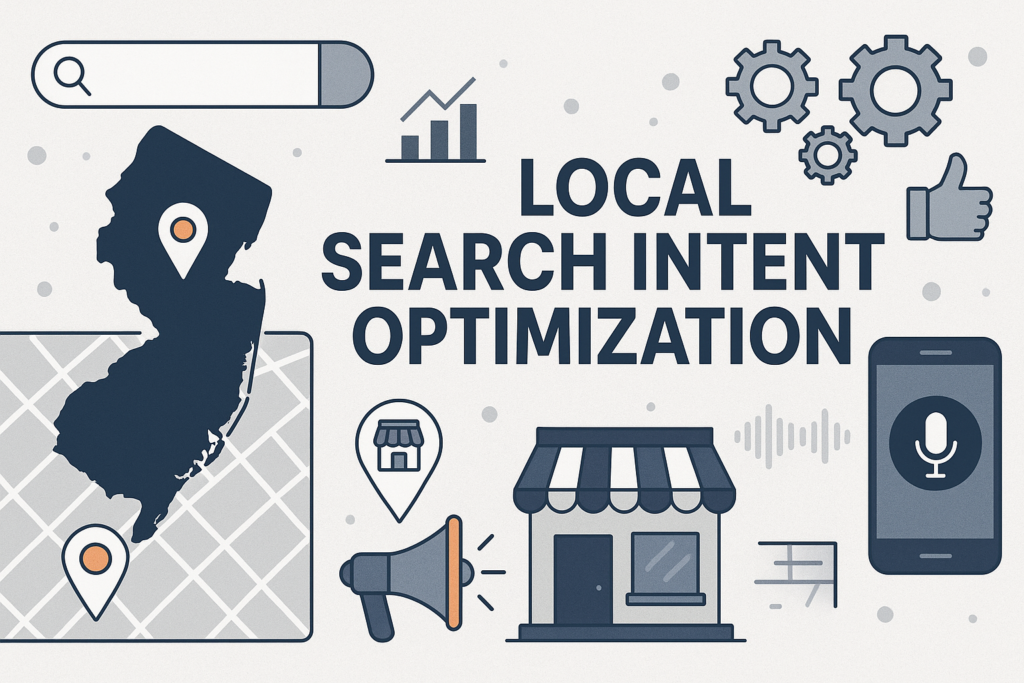The digital landscape in New Jersey is rapidly evolving, with businesses facing an unprecedented shift in how customers discover and interact with local services. As voice search adoption continues to surge, traditional SEO strategies are no longer sufficient for capturing the attention of today’s conversational searchers. Every NJ SEO Expert understands that optimizing for local search intent has become the cornerstone of successful digital marketing campaigns across the Garden State.
This comprehensive guide explores the critical strategies New Jersey businesses need to implement to dominate conversational search queries and voice search patterns. From understanding the nuances of “near me” queries to implementing advanced schema markup, we’ll cover everything local businesses need to know to stay competitive in 2025’s voice-first world.
Table of Contents
ToggleThe Voice Search Revolution Transforming New Jersey Business Discovery
Voice search has fundamentally changed how consumers find local businesses, with significant implications for every SEO expert in New Jersey working to boost client visibility. The statistics paint a clear picture of this dramatic shift in consumer behavior, revealing opportunities that forward-thinking businesses can leverage immediately.

Voice Search Adoption Statistics for 2025 – Key Metrics for Local Businesses
The data reveals compelling trends that no SEO Consultant in New Jersey can afford to ignore. With 72% of consumers now using voice search daily and 58% specifically using it to find local businesses, the opportunity for New Jersey companies to capture high-intent traffic has never been greater. Mobile devices dominate this space, accounting for 90.5% of all voice searches, making mobile optimization crucial for local success.
These statistics become even more significant when considering New Jersey’s dense population and competitive business environment . Voice search users typically exhibit higher purchase intent than traditional text searchers, often seeking immediate solutions to local needs. This behavioral shift means businesses optimized for voice search can capture customers at the exact moment they’re ready to make a purchase decision.
Understanding Local Search Intent Types in the New Jersey Market
Successful voice search optimization begins with understanding the different types of local search intent that drive consumer behavior across New Jersey’s diverse municipalities. Each intent type requires specific optimization strategies to capture and convert potential customers effectively.

Distribution of Local Search Intent Types in New Jersey Market
The distribution of local search intent reveals critical insights for any New Jersey SEO agency developing comprehensive optimization strategies. Transactional intent dominates at 45%, representing users ready to make immediate purchases or hire services. These searches often include urgent modifiers like “now,” “today,” or “emergency,” making them incredibly valuable for local businesses.
Informational intent accounts for 30% of local searches, with users seeking knowledge about local businesses, services, or areas. These queries often begin with question words like “what,” “where,” “how,” or “why,” followed by location-specific terms . Navigational intent represents 15% of searches, typically involving users looking for specific business locations or contact information.
Commercial investigation intent, while smaller at 10%, represents users in the crucial comparison phase before making purchase decisions. These searches often include terms like “best,” “reviews,” “compare,” or “vs,” combined with local modifiers. Smart businesses optimize for all intent types to capture customers throughout their entire decision-making journey.
Voice Search Optimization for “Near Me” Queries in New Jersey
“Near me” queries have become the gold standard for local search intent, with voice search users naturally incorporating these phrases into their conversational queries . Every Local SEO specialist New Jersey must understand how to optimize for these high-conversion searches that directly translate to foot traffic and phone calls.
The key to “near me” optimization lies in understanding that voice search users phrase these queries differently than text searchers . Instead of typing “pizza near me,” voice users ask “Where’s the best pizza place near me?” or “Find pizza delivery close to my location” . This conversational approach requires content optimization that mirrors natural speech patterns.
Technical optimization for “near me” queries involves several critical components. First, businesses must ensure their Google Business Profile is completely optimized with accurate NAP (Name, Address, Phone) information, operating hours, and service descriptions. Second, website content should naturally incorporate location-specific terms and conversational phrases that mirror how people speak.
Local citation consistency becomes crucial for “near me” success, as voice assistants pull information from multiple sources to provide answers. Businesses must maintain identical information across all online directories, review platforms, and social media profiles . This consistency signals authority to search engines and increases the likelihood of appearing in voice search results.
Conversational Keyword Research and Implementation Strategies
Traditional keyword research methods fall short when optimizing for voice search, requiring a fundamental shift toward understanding natural language patterns. Modern conversational keyword research focuses on question-based queries and longer, more specific phrases that mirror actual speech.
The process begins with identifying the questions customers actually ask about your services. Tools like AnswerThePublic and Google’s “People Also Ask” sections reveal common question patterns, but the most valuable insights come from direct customer interactions. Sales teams, customer service representatives, and front-desk staff hear the exact language customers use when seeking services.
Long-tail conversational keywords typically perform better for voice search than short, generic terms. For example, instead of targeting “plumber,” businesses should optimize for “emergency plumber who can fix burst pipes in Hoboken” or “licensed plumber available Sunday evening in Bergen County” . These longer phrases face less competition while attracting highly qualified prospects .
Implementation requires strategic placement of conversational keywords throughout website content, blog posts, and FAQ sections. Content should read naturally while incorporating the specific phrases customers use when speaking their searches. This approach helps search engines understand content relevance while providing valuable information to users.
Local Search Intent Mapping for Different NJ Municipalities
New Jersey’s unique municipal structure, with 564 distinct municipalities across 21 counties, requires sophisticated local search intent mapping strategies. Each municipality has distinct characteristics, demographics, and search patterns that affect how residents discover local businesses.

Top New Jersey Counties by Population – Priority Markets for Local SEO
Understanding population density and demographics helps prioritize optimization efforts across New Jersey’s diverse landscape. Bergen County leads with over 955,000 residents, followed closely by Essex and Middlesex counties, each exceeding 863,000 people. These high-population areas represent the greatest opportunities for local businesses but also face the most competition.
Municipal-specific optimization requires understanding local terminology, landmarks, and cultural references that residents use in their searches. For instance, residents of Jersey City might reference specific neighborhoods like Newport or The Heights, while those in Princeton might mention the university or specific shopping areas . Incorporating these local references into content helps businesses appear more relevant to area-specific searches.
Different municipalities also exhibit varying search patterns based on their urban, suburban, or rural characteristics. Urban areas like Newark or Jersey City see more immediate-need searches (“open now,” “24 hours”), while suburban municipalities might have more research-oriented queries (“best family restaurant,” “top-rated pediatrician”). Understanding these patterns allows businesses to tailor their optimization strategies accordingly.
Natural Language Query Patterns for Local Businesses
Voice search users employ distinctly different language patterns compared to text searchers, requiring businesses to optimize for natural, conversational queries. These patterns reflect how people actually speak rather than how they type, creating new optimization opportunities for businesses that understand the nuances .
Question-based queries dominate voice search, with users asking complete questions rather than using keyword fragments. Common patterns include “Where can I find,” “What’s the best,” “How do I,” and “Who provides” followed by service descriptions and location modifiers. For example, voice users ask “Where can I find organic pet food in Morristown?” rather than typing “organic pet food Morristown”.
Temporal modifiers appear frequently in voice searches, as users often seek immediate solutions. Phrases like “open now,” “available today,” “emergency,” “same day,” and “this weekend” indicate high-intent searches that businesses should prioritize. These temporal elements help search engines understand urgency and prioritize businesses that can meet immediate needs.
Local context plays a crucial role in natural language queries, with users incorporating landmarks, neighborhoods, and local references. Instead of formal city names, voice searchers might reference “near the mall,” “by the train station,” or “close to downtown”. Businesses that understand and optimize for these local references gain significant advantages in voice search results.
Schema Markup for Enhanced Local Search Understanding
Schema markup serves as the foundation for helping search engines understand local business information and context . Every Voice search optimization expert NJ recognizes that properly implemented structured data significantly improves the chances of appearing in voice search results and featured snippets.
Local business schema provides search engines with specific information about business operations, services, and locations. This structured data includes business name, address, phone number, operating hours, service areas, and accepted payment methods. Voice assistants rely heavily on this structured information to provide accurate responses to local queries.
Advanced schema implementations can include service-specific markup, review aggregation data, and FAQ structured data. These additional layers help search engines understand the full scope of business offerings and common customer questions. Businesses with comprehensive schema markup often outperform competitors in voice search results.
Implementation requires technical expertise but provides substantial long-term benefits. The markup must be accurate, complete, and regularly updated to maintain effectiveness. Testing tools like Google’s Rich Results Test help ensure proper implementation and identify potential issues.
Long-tail Keyword Optimization for Location-Specific Services
Long-tail keyword optimization becomes crucial for capturing voice search traffic, as conversational queries naturally tend toward longer, more specific phrases. These extended keyword phrases face less competition while attracting highly qualified prospects who know exactly what they’re seeking.
Location-specific long-tail keywords combine service terms with geographic modifiers and conversational elements. Examples include “emergency dental care Sunday evening in Trenton,” “pet grooming services accepting new clients in Somerset County,” or “family law attorney specializing in divorce in Morris County”. These phrases mirror actual customer language while targeting specific local markets.
The optimization process involves identifying service-location combinations that align with business capabilities and market demand. Businesses should focus on keywords that represent their core services in areas they actually serve. This targeted approach ensures optimization efforts support actual business growth rather than generating irrelevant traffic.
Content creation around long-tail keywords requires natural integration that serves both search engines and human readers. Blog posts, service pages, and FAQ sections provide excellent opportunities to incorporate these longer phrases while providing valuable information to potential customers. The key lies in maintaining readability while strategically placing optimization elements.

Voice Search Optimization Infographic for New Jersey Local Businesses
Conclusion: Embracing the Voice-First Future in New Jersey
The transformation of local search through voice technology represents both a challenge and an unprecedented opportunity for New Jersey businesses. Companies that proactively optimize for conversational search queries and voice search patterns will capture market share from competitors still relying on outdated SEO strategies .
Success in this voice-first environment requires comprehensive understanding of local search intent, strategic implementation of conversational keywords, and technical optimization that supports natural language queries. Businesses must adapt their content, markup, and overall digital presence to serve the growing population of voice search users who expect immediate, accurate, and locally relevant results.
The investment in voice search optimization pays dividends through increased visibility, higher-quality traffic, and improved conversion rates. As voice technology continues advancing and adoption rates climb, businesses that establish strong foundations now will maintain competitive advantages for years to come. The question isn’t whether to optimize for voice search, but how quickly businesses can implement these critical strategies to capture their share of this rapidly growing market.

